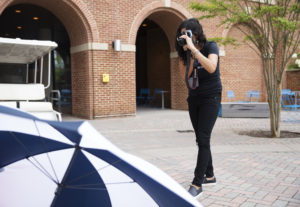It was a camera-microphone combo. That much was clear. But amid all the gadgets and gizmos, the group at the table could only guess what to do with the orange and white rings that came with it. That’s when Tricia Creason-Valencia spoke up. A cinema professor from Santa Clara University in California, she said they were filters, used to diffuse and manipulate light.
Knowledge-sharing like this went viral this week in a course called Digital Storytelling. Taught by University of Mary Washington Digital Knowledge Center Director Martha Burtis, it was part of UMW’s weeklong Digital Pedagogy Lab, a community of educators from across the globe, committed to dissecting the art and science of teaching with technology. The event, which drew participants from across the country – and world – wraps up today.

Digital Storytelling was one of several four-day tracts that had educators working in cohorts to tackle topics like “Writing About Teaching,” taught by UMW Division of Teaching and Learning Technologies Director Jesse Stommel, and “Design for Change,” taught by Middlebury College Provost for Digital Learning Amy Collier.
Burtis divided her class – teachers from campuses near and far – into four stations: video, photography, writing and design, all key components of tales spun with technology. Based on the DS106 course she teaches to Mary Washington students, the session explored how computers and other digital tools can be used to create dynamic narratives.
It contained “just enough structure with lots of options and lots of support,” said Carla Stellrecht, senior instructional consultant at the University of Michigan – Ann Arbor.

At tables piled high with microphones, headsets, video cameras, laptops and more, talk turned to tech-savvy topics like metadata, QuickTime and WordPress. Whiteboards awash with brainstormed ideas set the stage for discussions about things like photo ethics, noise layering and voice threads.
Psychology professor Naomi Hall-Byers plans to take what she learned this week back to Winston-Salem State University, where she’s working with students to explore the culture of success. “I’m trying to figure out how to incorporate more forms of media into it,” said Hall-Byers, who especially liked Burtis’ five-photo-story-assignment idea.
Assistant Professor of Media and Communication Kate Ranieri came to DPL with five of her colleagues from Pennsylvania’s Muhlenberg College. She hoped to tap into tools that could help with her project to digitize photos, sheet music and other memorabilia from the centuries-old Allentown Band. English professor Marissa Juárez, at DPL with a half dozen coworkers, planned to apply what she learned to Central New Mexico Community College’s version of the BYOD – Bring Your Own Device – initiative.

UMW Professor of Geography Melina Patterson traveled just steps from her office in Monroe Hall to attend DPL in the Hurley Convergence Center. She picked Burtis’ brain for ways to jazz up her Geographies of Children course. A DPL regular, Patterson has attended the event each of the three years it’s been held at UMW, its new permanent home.
“I find it an incredibly useful space just for thinking things through,” she said. “I feel like I learn about things I would not have considered had I not come here.”



